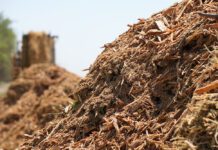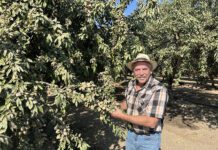For an almond grower, practicing postharvest irrigation and providing proper nutrients to the trees after the busiest season of the year is a way to “pay it forward” for next year’s crop.
By the end of September, flower formation inside the buds is coming to an end and next year’s crop yield potential is set. The principle is simple: greater flower development in the current season may result in greater return the following season. Taking care of those recently developed buds with good water and nutrient management will maximize next year’s fruit-set.
Like many things in life, preparation is key, and preparing your trees for the upcoming crop year requires that you make a plan to make it happen. Creating an irrigation and nutrient management checklist, for example, can help you ensure you’re taking the proper steps prepare your trees for life after dormancy.
Step 1: Reference the Almond Irrigation Improvement Continuum
In the fall, it is crucial that growers ensure their irrigation systems are working uniformly throughout their orchards, as the trees’ water needs are significant during this time and severe water stress can reduce new year’s bloom, fruit set and even yield. To avoid these consequences, growers are strongly recommended to reference an informative source aimed at helping them better understand irrigation management both postharvest and year-round: the Almond Irrigation Improvement Continuum. The Continuum provides a wide-ranging look at a grower’s site-specific irrigation system with the goal of improved efficiency and effectiveness.
This resource, developed by the Almond Board of California (ABC) in partnership with respected technical experts, provides a step-by-step explanation of irrigation management and scheduling practices related to the following concepts:
- Measuring irrigation system performance and efficiency
- Estimating orchard water requirements based on evapotranspiration
- Determining applied water
- Evaluating soil moisture
- Evaluating plant water status
Tom Devol, senior manager of Field Education and Outreach at the Almond Board, and specialist Ashley Correia are both available to help almond growers assess their irrigation systems and help determine potential issues with achieve optimized water efficiency. To schedule an in-orchard visit, growers can email Devol at tdevol@almondboard.com or call at (209) 343-3231.
Step 2: Step Back and Assess Need for Fall Nitrogen Application
Once you triple check that your irrigation systems are performing properly, it is time to evaluate your trees’ need for a nitrogen (N) application in the fall. Applications of N postharvest may be necessary to meet your trees’ N demand; however, there are instances when N applications are inefficient and unhelpful.
In the following situations, N applications are not needed:
- Trees are already adequate in N levels per July/August leaf analysis: Leaf analysis is one of the best indicators to determine N status. If the July leaf N value is higher than 2.5 percent, a fall N application is likely not necessary.
- There is a sufficient amount of N available to supply the trees’ demand: If you want to have a better indication of your soil’s N levels, consider conducting a soil sample. If you choose to do so, make sure to draw your sample from active roots and closely follow laboratory protocols.
- Tree health is suboptimal when you plan to apply N: This may be the case if, for example, your trees are too stressed during harvest or will be too stressed postharvest due to dry down, water limitations, salinity, etc. Trees in suboptimal health will likely have very few leaves in the canopy and those leaves will look yellow.
Applying N when your trees have poor health conditions, or when your trees and soils already have sufficient soil levels, will likely result in N loss through leaching or gaseous losses. N loss subsequently brings little to no benefit to flower development.
Step 3: Consider Boron, Zinc Sprays
Postharvest is also a good time to consider nutrient uptake through the trees’ leaves via foliar applications. There are two key micronutrients to consider: boron and zinc.
Boron (B) plays a key role during flowering as it promotes the elongation of the pollinic tube, therefore promoting fruit set. Maintaining adequate B in your tree buds is especially beneficial during bloom. However, too much or too little B will have the opposite effect—reduced fruit set.[1] Growers must ensure, therefore, that B is only applied if needed. The adequate range for B is 60-160 ppm (parts per million), and B will likely not need to be applied if levels are at the upper end of this range.
Growers often apply large amounts of zinc sulfate spray in the fall to improve tree Zinc (Zn) status. However, while a fall Zn application may be beneficial to control rust inoculum by promoting leaf drop, research shows that this application does not increase the Zn concentration in trees. In fact, new findings suggest that Zn uptake in trees mostly occurs when Zn is applied in early spring.[2]
For more information on nutrient recommendations and critical ranges, visit Almonds.com/Nutrients and UC Davis’ Almond Nutrients & Fertilization page, found at FruitsandNuts.UCDavis.edu/AlmondPages/AlmondNutrientsFertilization/.
[1] Nyomora, A.M.S., P.H. Brown, and M. Freeman. 1997. Fall Foliar-Applied Boron Increases Tissue Boron Concentration and Nut Set of Almond. Journal of the American Society for Horticultural Science. 122:405-410.
[2] Saa S., C. Negron, P. Brown. 2018. Foliar Zinc Applications in Prunus: From Lab Experience to Orchard Management. Scientia Horticulturae 233: 233 -237.
















